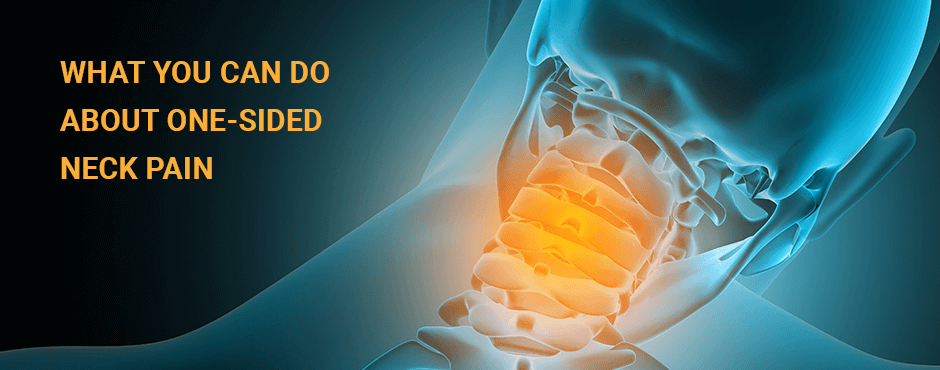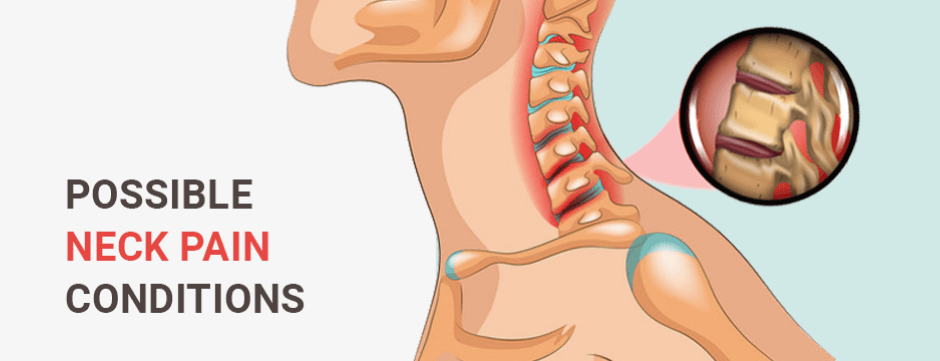Neck pain is, well…a real pain in the neck! It seems to appear out of nowhere, and sometimes vanishes just as quickly. But when neck pain lingers, it can signal other issues that need your attention. After all, pain is your body’s way of drawing your attention to a physical problem, and ignoring it is not likely to make it go away. Knowing when to seek neck pain treatment is key to preventing further damage.
Neck pain is often more pronounced on one side of the neck over the other. That is not totally surprising, given that the neck encompasses your spinal cord, and multiple neural bodies that travel to and from your central nervous system and peripheral appendages. And then there is the bowling ball called your head, held in place by multiple muscles, tendons and ligaments. Because we do not use our bodies in symmetrical ways, it is easy for one side of your neck to do more than its share of stabilizing your head.
Common causes of neck pain include:
- Repetitive unilateral movement patterns of the head, shoulder and arm, like serving a tennis ball or swinging a golf club.
- Lopsided sleeping positions, with inadequate neck support.
- Electronic devise use with your head in a forward-tilting position.
- Excessive sitting with poor posture.
- Being in poor physical condition, with weakened muscle tone throughout your body.
- Faulty walking gait mechanics.
- Wearing a shoulder bag on one side of your body.
- Degenerative wear and tear from aging.
- Trauma from sports.
- Whiplash from a car accident.
While the underlying cause of neck pain is sometimes obvious, more often than not its origin is unclear. An experienced chiropractor or neck pain specialist can help determine the source of your neck pain, and provide individualized treatment to resolve it.
Neck pain is often non-specific in nature, meaning the exact cause is difficult to detect. However, there are several conditions that can be diagnosed with ultrasound or MRI.
- A herniated or bulging disc. This happens when the inner squishy core of one of your cervical vertebrae becomes inflamed and protrudes, placing pressure on a nerve root. The discs in your cervical spine serve as shock absorbers, absorbing impact forces and keeping the bones of your vertebra from rubbing together. A disc can begin to bulge when your neck is held out of alignment for long periods of time, like when you spend hours each day texting or scrolling through social media. Herniated discs often resolve themselves if given proper care and attention, and surgery is rarely necessary.
- Nerve impingement in your neck and upper back. Nerves can become entrapped or impinged for a number of reasons. Sometimes nerve impingement is related to a disc herniation, but it can also accompany a repetitive overuse injury from work or exercise. Overhead athletes like swimmers or baseball pitchers may experience nerve impingement. Chronic stress and tense muscles can also put pressure on nerves, causing pain in your neck.
- Myofascial pain syndrome. Myofascial trigger points are tiny muscle spasms in your fascia, the thin resilient sheathe of tissue that encases your muscles. They can cause pain in your muscles and tendons, especially when located in your neck and upper back.
- Cervical degenerative disc disease. Over time, the discs in your cervical vertebrae can become dry and lose some of their rubbery quality, thereby losing their capacity to absorb shock. This may cause your vertebral facet joints to rub against each other, and put pressure on nerves. Certain medications and low levels of physical activity can contribute to disc degeneration.
- Cervical osteoarthritis. The wearing away of cartilage in your cervical facet joints can cause cervical osteoarthritis, a common cause of chronic neck pain, especially in older adults.
- Myofascial pain syndrome. Myofascial trigger points are tiny muscle spasms in your fascia, the thin resilient sheathe of tissue that encases your muscles. They can cause pain in your muscles and tendons, especially when located in your neck and upper back.
Because there are so many things that can cause neck pain, getting an accurate diagnosis is critical. A wrong diagnosis can mean prolonged pain as you undergo the wrong treatment. Cervical spinal surgery is risky, and often fails to resolve neck pain. At NYDNRehab, we use the highest resolution research-grade diagnostic ultrasound to view the structures of the neck in real time. It enables us to view the full length of neural bodies, to find specific points of impingement, and to visualize deeply embedded trigger points. Combined with postural assessment, gait analysis and other tools, we arrive at an accurate diagnosis so we can get right to work on the best plan of treatment.
Some of our treatment strategies include:
For the best neck pain therapy in Manhattan, visit NYDNRehab. Whether you need to see a chiropractor or get advanced physical therapy, we have the best-equipped clinic in NYC. We use cutting-edge technologies and innovative treatment methods to get to the source of your pain and eliminate it for good. Contact us today, and get rid of the pain in your neck so you can enjoy living again.



























































